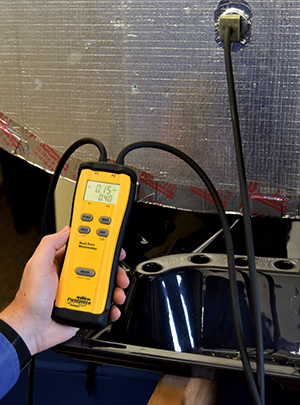Using wireless test instruments and software, each test helps diagnose a duct system through static pressure and airflow measurements. Plus, these two examples can help convert measurements to simple concepts and reports that are easy for industry professionals and their customers to understand.
Duct System Screening
The Duct System Screening test uses wireless manometers, such as the TEC DG-8 or Fieldpiece JL3MN, to communicate static pressure measurements from four locations to the MeasureQuick app. You can use a single wireless manometer and capture readings one at a time or four wireless manometers to profile the entire system with one click.
Next, you need to assess fan airflow using total external static pressure (TESP), the fan speed, and a fan table. A tech uses these tools to estimate fan airflow moving through the air-handling equipment.
Instead of a technician performing all the math, looking up static pressure budgets, and calculating percentages, the Duct System Screening test performs these tasks in a split second. By working smarter, a tech – who may have been intimidated by this process or didn’t grasp the principles – can quickly look at the airside.

They can live stream their data to a senior tech or service manager if there’s a problem. Everyone can see and diagnose TESP, airflow, filter pressure drop, coil pressure drop, and duct pressures simultaneously.
Finally, the technician can email the visual PDF report to the customer and the office to share the results and ensure everyone understands. Technicians don’t have to interpret the results and discuss anything with the customer if they don’t want to. This method sure beats losing the paperwork or writing your readings in a notepad in your shirt’s front pocket, never to see them again.
The Duct System Screening test is ideal for helping techs diagnose airside issues and generate leads for poorly performing duct systems on maintenance or emergency service calls.
Duct System Analysis
While the Duct System Screening test serves as a tool to help a technician identify poorly performing airside issues, the Duct System Analysis test takes the testing principles one step further and looks at measured airflow. A salesperson can use it to gather additional information with simple steps that don’t require a lot of technical ability.
One hurdle many High-Performance HVAC contractors face is getting their salespeople to gather static pressure and airflow measurements. These tests and measurements are outside their comfort zone unless the salespeople have a technical background.
Suppose a technician has already performed a Duct System Screening test. In that case, the salesperson only must take one pressure measurement in the supply plenum through a pre-installed test port and then get a direct airflow measurement using a test instrument known as the Digital TrueFlow Grid from The Energy Conservatory (TEC).
To perform a Duct System Analysis test, you’ll need the Digital TrueFlow Grid and companion DG-8 micromanometer.
This micromanometer communicates via Bluetooth with the TrueFlow Grid and either the MeasureQuick app or TEC’s True Flow app (which also integrates with MeasureQuick).
Salespeople Remain Important
The testing principles, at a minimum, require a salesperson to measure static pressure in the supply plenum with the air filter installed. Next, they remove the air filter and replace it with the Digital TrueFlow Grid in the filter rack or a filter grille. Then they turn the air-handling equipment back on, and the TrueFlow measures airflow directly. No interpreting a fan table or guessing how dirt on the blower wheel affects your measurement accuracy. The TrueFlow is a direct measurement device that isn’t affected by these conditions, whereas a static pressure measurement is.
Click Below for the Next Page:













Recent Comments